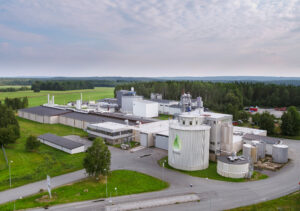The energy in biogas can be exploited in different ways. For example, it can be used for local heating or remote heating (via district heating networks). Biogas can also be used to generate electricity, thus contributing to an increased proportion of ‘green electricity’ distributed through the grid.
Biogas offers numerous environmental and social benefits, one of which is its potential to replace fossil fuels, thereby reducing greenhouse gas emissions and improving air quality in urban areas. As a renewable energy source, biogas produces no net CO2 emissions when burned.
Biogas as a vehicle fuel is the area of application increasing the most rapidly. Biogas that has been purified and upgraded to contain a high proportion of methane may with advantage be used as a vehicle fuel. Methane can also be used as a raw material in various manufacturing processes, with diverse final products such as paints, plastics, furniture, animal feeds, and lubricant oils. In addition, the biogas process generates a nutrient-rich digestion residue, that can be used as a fertilizer.

Image by Ulf Grünbaum/Imagebank.sweden.se
In Sweden, biogas has been produced at municipal wastewater treatment plants since the 1960s. The primary incentive was to reduce sludge volumes. However, the oil crises of the 1970s changed attitudes, leading to research and development into biogas techniques and the construction of new plants in order to reduce environmental problems and dependency on oil. The industry was the first to act; sugar refineries and pulp mills started to use anaerobic digestion for wastewater purification in the 1970s and 1980s. At this time, several smaller farm-sized plants were also constructed for anaerobic digestion of manure.
During the 1980s, several landfill plants started to collect and utilize biogas produced in their treatment areas, an activity that expanded quickly during the 1990s. Several new biogas plants have been constructed since the mid-1990s to digest the food industry and slaughterhouse wastes, and kitchen wastes from households and restaurants.
Source: www.energigas.se